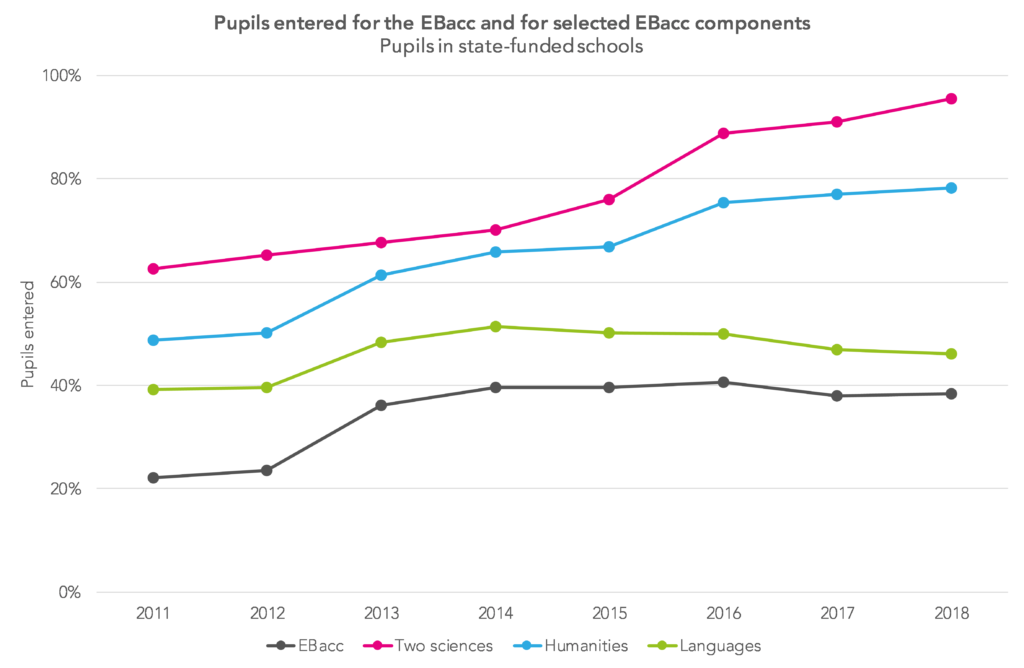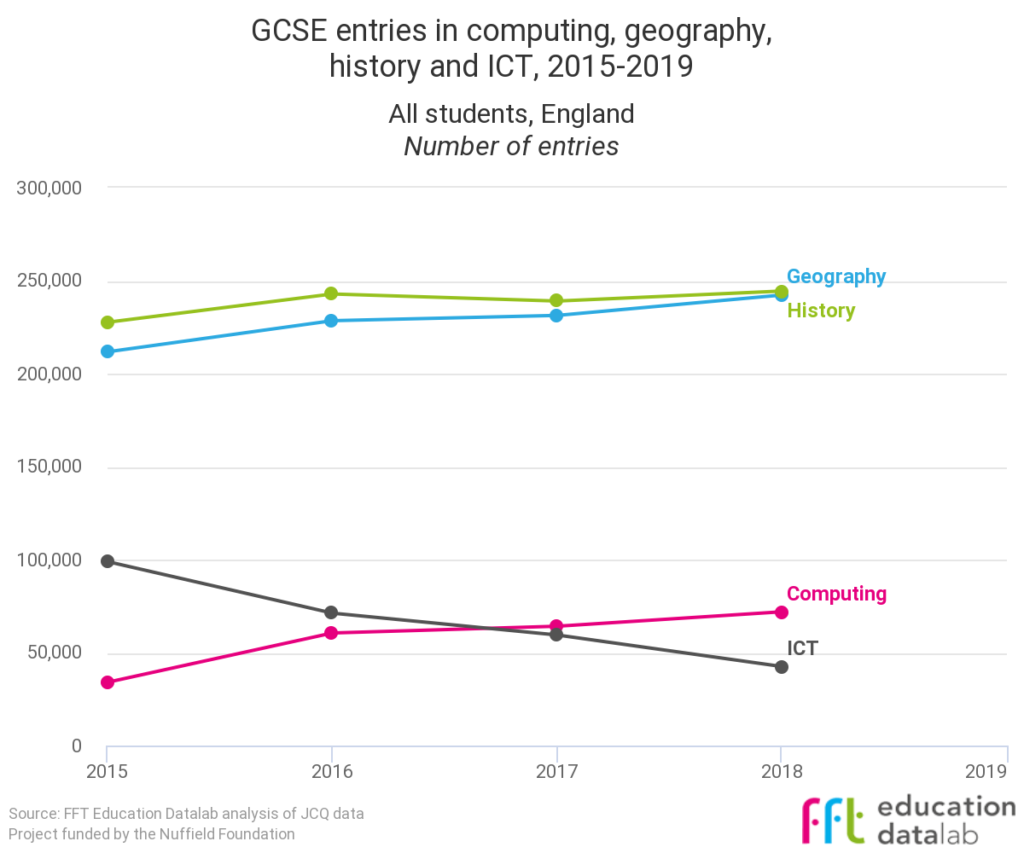GCSE results come out on Thursday, and there are a number of things it’ll be worth looking out for. Here are our top four.
1. Entries in EBacc subjects are likely to be up overall – entries in non-EBacc subjects down
In recent years there has been a shift towards pupils taking the basket of academic subjects that make up Nick Gibb’s cherished English Baccalaureate (EBacc).
Despite this, EBacc entry rates for pupils in state schools have hovered around the 40% mark for a number of years, as the chart below shows, but this is solely because of falling numbers of pupils entering language GCSEs.

We’re expecting the number of entries into individual EBacc subjects to have increased again this year – including modern foreign languages (more on which below).
A note on coverage
Unless otherwise stated, all figures in this post relate to England only – though results for Wales and Northern Ireland will also be published on Thursday.
The exams regulator for England, Ofqual, publishes provisional data on GCSE entries in May. While these don’t take into account late entries they give a fairly good idea of changes in entry numbers from one year to the next.
These figures suggest that we can expect to an increase in the number of entries in EBacc subjects in England in the region of 150,000, or 4%, and a decrease in the number of entries in non-EBacc subjects in the region of 100,000, or 9%. (It’s worth saying that this summer’s 16-year-old population is a little more than 1.5% larger than last summer’s – years of this reducing have now come to an end.)
Looking at it a slightly different way, the proportion of all GCSE entries this year that are in EBacc subjects is likely to be around 80% – up from more like 70% three years ago.
This looks likely to be driven by notable increases in some individual EBacc subjects, discussed below.
But it’s worth taking a step back, and noting that is more complicated than EBacc up, non-EBacc down.
While the provisional Ofqual data suggests that there have been drops in entry numbers for some non-EBacc subjects – design and technology down in the region of 23%, religious studies down something like 4% – there are other non-EBacc subjects where it looks like we can expect entries to be up, including art and design subjects (up around 9%), business studies (up around 5%) and citizenship studies (up by 9%).

Lots of non-EBacc subjects – such as ICT, and health and social care – have been discontinued, however. And if a subject doesn’t exist, you can’t enter it.
When we look at non-EBacc subjects that haven’t been discontinued, the provisional data suggests the fall in non-EBacc entries may only be in the region of 2%, rather than the 9% decrease for that it appears to be on first glance.
2. The total number of language entries is probably going to have gone up
Again looking at the provisional Ofqual data, we’re expecting to see increases in French and Spanish GCSE entries in the region of 5,000 (roughly 4%) and 9,000 (around 10%) respectively. Entries into German appear to have fallen by around 1,000 (2.5%), with a small drop also in other modern languages.

As the chart above shows, if these numbers are borne out on Thursday that would represent an end to the decline in the number of French entries, and a continuation of the general increase in Spanish entries. And overall it would mean an increase of something like 13,000 in the number of modern language entries.
3. Increases will be recorded in history and computing entries
Among the EBacc subjects, history and computing look likely to have had the largest percentage increase in entries besides Spanish.
History entries look like they’ll be up by roughly 6.5%, with computing entries up more like 8%.

While still a relatively small subject, this would be a continuation of the increases in computing entries seen since its introduction in 2014, as the chart above shows – a beneficiary of the discontinuation of ICT GCSE in England.
4. The national reference test is unlikely to have much impact this year
Finally, something slightly technical but important.
When awarding exam grades, regulators in each of the home nations (Ofqual in the case of England) apply a policy that benchmarks each year’s set of results against previous years’ based on Key Stage 2 attainment.
This generally means that the mix of grades awarded won’t move around much from one year to the next, unless senior examiners have compelling reason to think that the standard displayed in exam scripts is appreciably different to previous years.
Up till now, grades have been awarded using this combination of statistical predictions and examiner judgment. This year, for the first time, something called the national reference test (NRT) will provide additional evidence in England.
The test covers English and maths only, and Ofqual has confirmed that it will only be taken into account when setting grade boundaries in English language and maths GCSEs.
But even with this tweaked approach, we don’t expect the grades awarded in these two subjects to have changed very much this year.
The NRT is intended to provide a way of identifying small changes in performance over time. That, coupled with the fact that we’re talking about subjects which all bar a very small percentage of pupils take (so there won’t be big changes in entrant characteristics) means we’d be very surprised if grades in English language and maths move by more than fairly trivial amounts.
We’ll be publishing live analysis of this year’s GCSE entries and attainment from 9.30am on Thursday. Sign up to our mailing list to get notifications about new blogposts, or check back here on the day.
In the meantime, check out our microsite, which allows you to explore trends in entries and attainment yourself. We’ll be adding 2019 data at 9.30am on Thursday.






Do you know if the garde boundaries will be low for the GSCE English language results